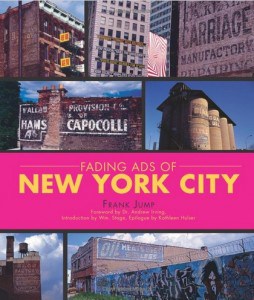4 Nov 2011
Fading Ads of New York City
The eagerly awaited release of Frank Jump’s ‘Fading Ads of New York City’ book is almost upon us. I was fortunate enough to be offered a sneak preview by Frank himself so here are some reflections on the book to whet your appetite and hopefully encourage you to get a copy as soon as it’s published in the UK and the USA.
First and foremost is the quality of photography and the specimens that Frank has captured in his daring escapades around New York. 72 examples are beautifully documented which, although representing just a fraction of his collection, offer up some of the best examples to be found in this city of signs. Two of my favourites are his first ever photograph, the four-storey Omega Oil, and the colourfully illustrated sign for M. Rappoport’s Music Store. The selection is diverse, providing excellent examples of many components of the painted form: scale; lettering; illustration; characters; slogans.
Accompanying each sign in the book is a well researched account of the history of the company advertised. This is then set within the context of the wider industry and its connection to New York. In this sense, the book is an historical account of the commercial history of the city and the districts within it. There are parallels to Ben Passikoff’s ‘The Writing on the Wall’, although Frank uses individual signs as his springboard into the wider historical context.
Perhaps the most striking difference between Frank’s book and others in the growing catalogue of Ghostsigns titles is the personal dimension that he brings to his work. The connections between his documentation of New York’s Fading Ads and his fight against HIV/AIDS are inescapable. He uses the unintended survival of the signs as a metaphor for his own survival against the odds, and is very candid in his account of his own story. In this respect, the book is part history, part autobiography, and I learned about more than just Ghostsigns from reading it.
Adding another layer of depth to the book are a series of written pieces by various figures including historians, academics, and fellow Fading Ad enthusiasts. There are nine in total including an introduction from Ghostsigns pioneer William Stage (author of the original ‘Ghost Signs’ book) and an extended essay considering the meaning of these signs in terms of time and place from Dr Andrew Irving of the University of Manchester. It is clear from these accompanying texts that Frank’s life and work has touched many people in a positive way. In fact, my own account of the encouragement he offered me in the early stages of my interest in hand painted advertising is one such contribution. (To what extent it adds any depth you can judge for yourself by downloading here…)
This book is a fantastic addition to the published material available on the topic and I learned a lot from it. I hope that the publishers will commission a sequel so that even more of Frank’s photography can find its way onto the printed page. In fact, it looks like it might be the first in a series of titles based on this recent announcement from Lawrence O’Toole.
[The book is available to buy on Amazon USA here, and will hopefully be available soon from Amazon UK here.]




